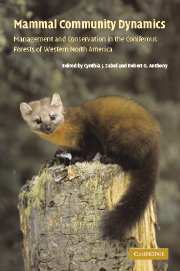 Mammal Community Dynamics
Mammal Community Dynamics Published online by Cambridge University Press: 15 December 2009
Introduction
Animals are not distributed randomly in time or space; rather their dispersion, movement, and distribution are strongly dictated by their evolutionary history and social organization. Some animals are relatively solitary or territorial, occupy specific microhabitats, and exhibit limited movement, whereas others are gregarious and not territorial, form herds, and migrate over large expanses of heterogeneous habitat. Similarly, not all animals respond the same way to habitat mosaics, habitat fragmentation, movement barriers, and human disturbance. Many of our predictions of how habitat loss and fragmentation affect native populations is through retrospection, speculation, or modeling, rather than by a priori predictions of how particular populations or species will respond to habitat perturbations. Our lack of understanding of how species respond to habitat alterations is such that species often are treated as mathematical entities (i.e., all individuals are “average”) and individual-, sex-, and species-specific differences in response to fragmentation are not considered (Andrén 1994, Lima and Zollner 1996). Thus, animals are not always distributed as predicted by spatially explicit models, GAP analysis, habitat suitability indices, and so forth (Boone and Krohn 2000).
Some of the observed versus predicted differences in distribution of species across landscapes or in response to fragmentation can be explained by differences in their evolutionary history, dispersal ability, and social organization (Wolff 1999). In this chapter I use evolutionary and behavioral theory to predict some of the demographic consequences of habitat alteration for populations of mammals distributed in continuous and fragmented forest landscapes.
To save this book to your Kindle, first ensure [email protected] is added to your Approved Personal Document E-mail List under your Personal Document Settings on the Manage Your Content and Devices page of your Amazon account. Then enter the ‘name’ part of your Kindle email address below. Find out more about saving to your Kindle.
Note you can select to save to either the @free.kindle.com or @kindle.com variations. ‘@free.kindle.com’ emails are free but can only be saved to your device when it is connected to wi-fi. ‘@kindle.com’ emails can be delivered even when you are not connected to wi-fi, but note that service fees apply.
Find out more about the Kindle Personal Document Service.
To save content items to your account, please confirm that you agree to abide by our usage policies. If this is the first time you use this feature, you will be asked to authorise Cambridge Core to connect with your account. Find out more about saving content to Dropbox.
To save content items to your account, please confirm that you agree to abide by our usage policies. If this is the first time you use this feature, you will be asked to authorise Cambridge Core to connect with your account. Find out more about saving content to Google Drive.